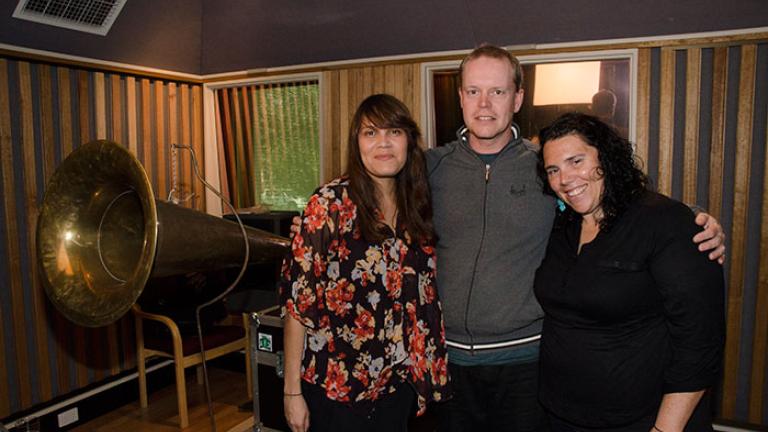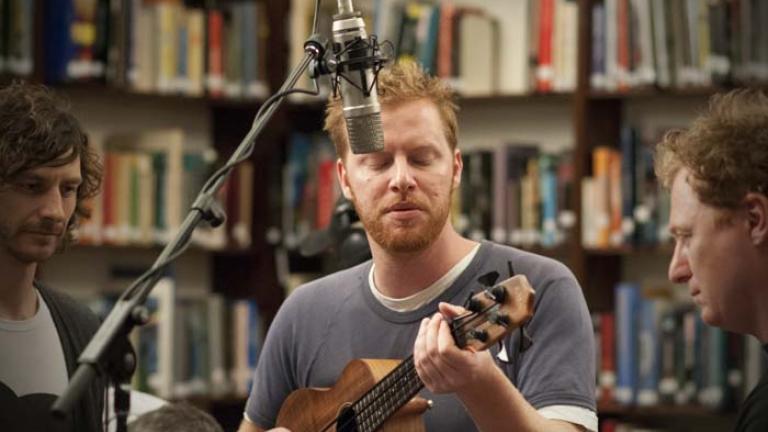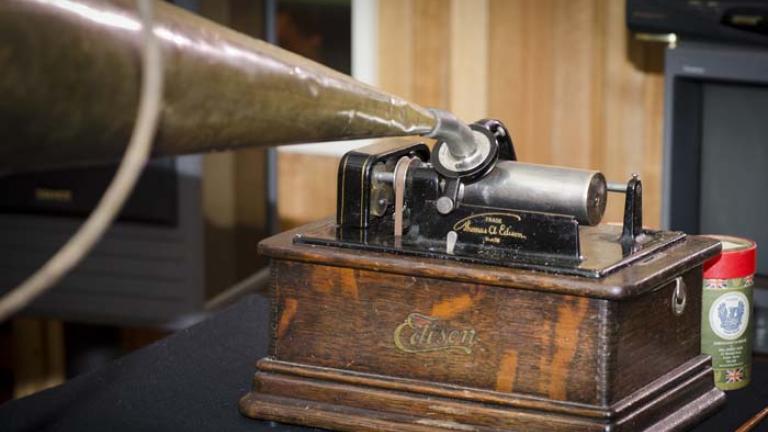

Stiff Gins and The Basics record on wax cylinder
Contemporary artists make new recordings on 19th century wax cylinder technology at the NFSA.
Where it all started: Stiff Gins
Stiff Gins (Kaleena Briggs and Nardi Simpson) sing 'Dust', a song in two Aboriginal languages, 2013. A wax cylinder recording made at the NFSA on an original 1903 Edison Standard D model phonograph.
Wax cylinder recording of ‘Dust’. Written and performed by Stiff Gins (Kaleena Briggs and Nardi Simpson). Footage courtesy ABC TV.
In early 2013 the Indigenous musical duo Stiff Gins (Nardi Simpson and Kaleena Briggs) approached the NFSA’s Peter White, Senior Manager, Indigenous Connections, about recording a wax cylinder. Nardi and Kaleena had heard the cylinder recordings made by Tasmanian Aboriginal woman Fanny Smith in 1903 and they were intrigued by the idea of making a similar recording for a new show.
On 4 September Stiff Gins arrived at the NFSA to record their song. We had warned them the cylinder could only hold two minutes and they had prepared a song to suit. As far as we can tell this is the first studio recording on wax cylinder since the demise of the Australia Moulded Record Co of Glebe, NSW in 1910 and quite possibly the first songs recorded in two Indigenous languages.
Below: Stiff Gins (Kaleena Briggs and Nardi Simpson) recording ‘Dust’ at the NFSA, 4 September 2013.

Stiff Gins (Kaleena Briggs and Nardi Simpson) recording 'Dust' at the NFSA, 4 September 2013.

Stiff Gins (Kaleena Briggs and Nardi Simpson) singing into the horn of the Edison phonograph.

Stiff Gins recording into the horn of an Edison Standard D model phonograph.

Stiff Gins (Kaleena Briggs and Nardi Simpson) recording at the NFSA on 4 September 2013.

Stiff Gins (Kaleena Briggs and Nardi Simpson) with NFSA audio technician Gerry O'Neill.
Back to Basics
Wax cylinder recording of ‘I Don’t Need Another’ (Schroeder/De Backer), published by ORiGiN and performed by The Basics. Originally released in 2003 on Get Back through MGM Distribution. More about The Basics can be found on their Wikipedia page.
When The Basics (Wally De Backer, Kris Schroeder and Tim Heath) visited the NFSA, we recorded a wax cylinder with them using an Edison Standard D model phonograph as a recording machine (see No handbook required, below).
Recording three vocalists accompanied by a 12-string guitar added complexity to the recording process. There is not much dynamic range available when recording onto a cylinder, so it is best if the performers’ volume is fairly consistent. Otherwise, unlike a modern recording system, they need to physically move towards – or away from – the horn of the phonograph to compensate!
Below: The Basics (Kris Schroeder, Wally De Backer, Tim Heath) recording ‘I Don’t Need Another’ at the NFSA, 3 October 2013.

The Basics (Kris Schroeder, Wally De Backer, Tim Heath) recording 'I Don't Need Another' at the NFSA, 3 October 2013.

The Basics (Wally De Backer, Kris Schroeder, Tim Heath) performing 'I Don't Need Another'.

Wally De Backer (Gotye) facing the horn of an Edison phonograph at the NFSA.

Wally De Backer, Kris Schroeder (centre) and Tim Heath.

The Basics (Kris Schroeder, Wally De Backer, Tim Heath) making a wax cylinder recording at the NFSA.

The Basics (Kris Schroeder, Wally De Backer, Tim Heath) singing 'I Don't Need Another' into the horn of the Edison phonograph.

The Basics: Kris Schroeder, Wally De Backer (centre) and Tim Heath.

Wally De Backer (Gotye) at the NFSA, 3 October 2013.
Seeking new sounds: Keith Potger
Keith Potger, one of the original members of The Seekers, enthusiastically recorded a two-minute version of his song ‘Guardian Angel, Guiding Light’. On the recording he also plays a 12-string guitar.
The shimmery overtones that help give 12-string guitars their distinct tonal colour are hard to capture with an acoustic horn recording, and incorporating the instrument into the recording certainly added another variable to the mix.
Below: Keith Potger recording ‘Guardian Angel, Guiding Light’ at the NFSA, 17 September 2013.

Keith Potger recording his wax cylinder at the NFSA.

Keith Potger singing into the horn of the Edison phonograph.

The Edison Standard D model phonograph used to record Keith Potger's wax cylinder.

Keith Potger recording 'Guardian Angel, Guiding Light’ at the NFSA, 17 September 2013.
No handbook required

There is no handbook for this 19th century technology. The NFSA archives equipment as well as recordings and, after some research, we decided to use an Edison Standard D model phonographs as a recording machine.
The phonograph dates from around 1908 and has a clockwork spring-powered motor. We fitted it with a recorder head that can play back two-minute cylinders, sourced from a supplier in the US, and obtained blank cylinders from Paul Morris in the UK.
Recording on this equipment is a purely mechanical process, with no electricity involved. The performer sings down a metal horn and the energy of that sound is concentrated onto a thin circular mica disc in the recorder head. The vibrations of the disc move a thin glass rod which cuts the spiral groove in the cylinder.
We experimented with two different conical horns but the longer (120 cm) produced a better recording than the shorter (100 cm). The distance of the performer from the horn is also critical; the performer has to be able to hear a reverberant echo coming back out of the horn for there to be enough mechanical energy to cut the groove.
Wax cylinder history

In the early 1890s Thomas Edison changed the world forever when he introduced the first commercially available phonographs, machines that could record and play back sounds. A cylinder about five cm in diameter and 11 cm long, made from waxes and metallic soaps, was the recording medium.
At first, each cylinder had to be recorded individually. However the need to reproduce in batches and increase sales potential led to developments in technology. Small batch production was enabled by pantographic machines and then, in the early 1900s, a moulding process was used which depended on the cooling wax cylinder shrinking enough to be extracted from an outside mould. The next step was moulding the cylinders from celluloid, the new wonder plastic material of the age.
But cylinders couldn’t complete with Emil Berliner’s flat disc record made from shellac. These were both easier to manufacture and came with two songs, one on each side. By the early 1920s prerecorded cylinders had been displaced entirely by discs. However the ease with which cylinder technology could be used as a recording device saw it utilised for dictation and they survived into the 1950s for this purpose. The NFSA collection includes the machine owned by Gwen Meredith, onto which she dictated the dialogue of Blue Hills, her long-running ABC radio serial.
The National Film and Sound Archive of Australia acknowledges Australia’s Aboriginal and Torres Strait Islander peoples as the Traditional Custodians of the land on which we work and live and gives respect to their Elders both past and present.


